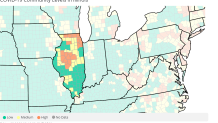
Getting ready for a COVID test
As the Centers for Disease Control and Prevention updated its county-by-county COVID map, several in the Chicago area remained under a high community level, while others dropped to medium.
Among the 19 Illinois counties under the highest alert level were five in the Chicago area.
Will, Cook, Lake, DuPage and McHenry counties in the Chicago area all remain under the high category.
Meanwhile, Kane, Kendall, LaSalle, Grundy and DeKalb counties are now under the medium risk. Kankakee County is the only Chicago-area county at a low community level, according to the CDC.

Under the guidelines released by the CDC, a county is considered to be at a “high community level” of COVID when its average number of weekly cases per 100,000 residents rises above 200, and when it either is averaging 10 weekly COVID hospital admissions or when it’s seeing 10% or more of its hospital beds occupied by COVID patients.
Counties that do reach a high community level are urged to reinstate mask-wearing for all individuals indoors regardless of vaccination status and to consider avoiding non-essential indoor activities. For a "medium community level," the designation means elderly or immunocompromised individuals are urged to wear masks in public indoor spaces.
Here's what the CDC recommends for individuals in "high" level regions:
- Wear a well-fitting mask1 indoors in public, regardless of vaccination status (including in K-12 schools and other indoor community settings)
- If you are immunocompromised or high risk for severe disease
- Wear a mask or respirator that provides you with greater protection
- Consider avoiding non-essential indoor activities in public where you could be exposed
- Talk to your healthcare provider about whether you need to take other precautions (e.g., testing)
- Have a plan for rapid testing if needed (e.g., having home tests or access to testing)
- Talk to your healthcare provider about whether you are a candidate for treatments like oral antivirals, PrEP, and monoclonal antibodies
- If you have household or social contact with someone at high risk for severe disease
- consider self-testing to detect infection before contact
- consider wearing a mask when indoors with them
- Stay up to date with COVID-19 vaccines and boosters
- Maintain improved ventilation throughout indoor spaces when possible
- Follow CDC recommendations for isolation and quarantine, including getting tested if you are exposed to COVID-19 or have symptoms of COVID-19
Feeling out of the loop? We'll catch you up on the Chicago news you need to know. Sign up for the weekly Chicago Catch-Up newsletter.
For communities:
- Consider setting-specific recommendations for prevention strategies based on local factors
- Implement healthcare surge support as needed
- Protect people at high risk for severe illness or death by ensuring equitable access to vaccination, testing, treatment, support services, and information
- Consider implementing screening testing or other testing strategies for people who are exposed to COVID-19 in workplaces, schools, or other community settings as appropriate
- Implement enhanced prevention measures in high-risk congregate settings (see guidance for correctional facilities and homeless shelters)
- Distribute and administer vaccines to achieve high community vaccination coverage and ensure health equity
- Maintain improved ventilation in public indoor spaces
- Ensure access to testing, including through point-of-care and at-home tests for all people
- Communicate with organizations and places that serve people who are immunocompromised or at high risk for severe disease to ensure they know how to get rapid testing
- Ensure access and equity in vaccination, testing, treatment, community outreach, support services for disproportionately affected populations

